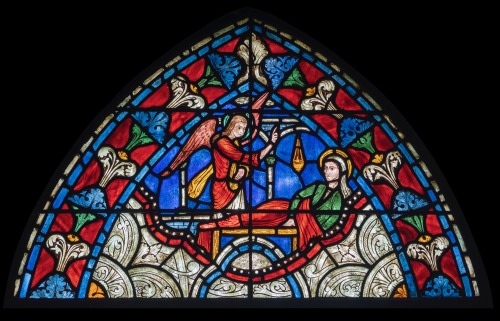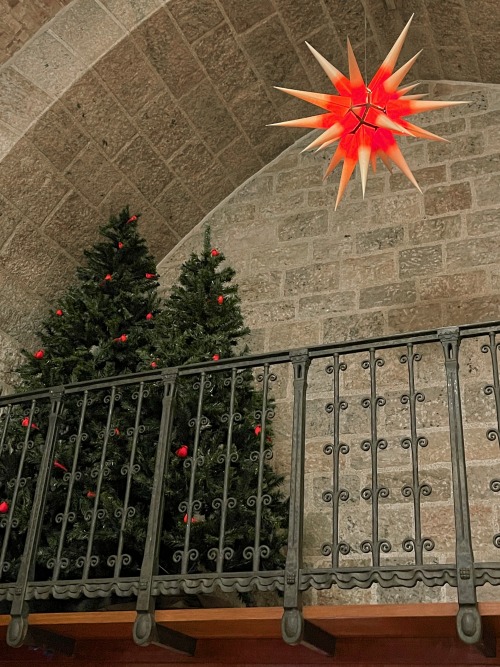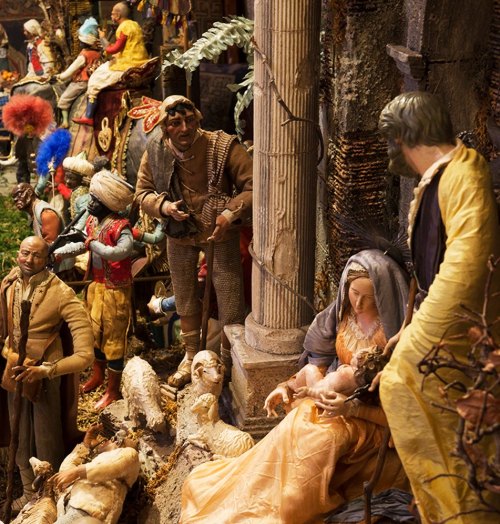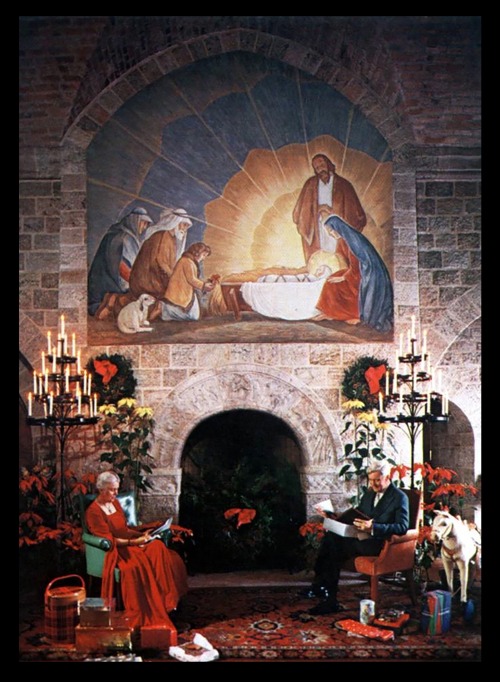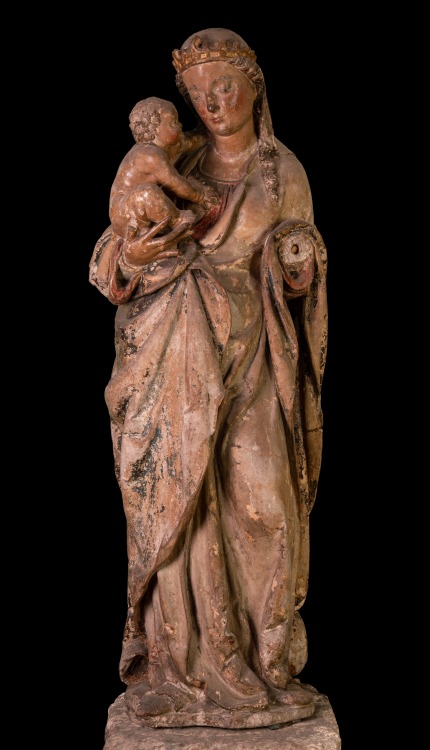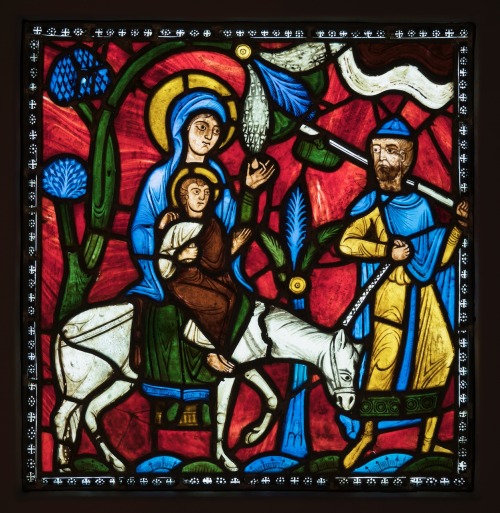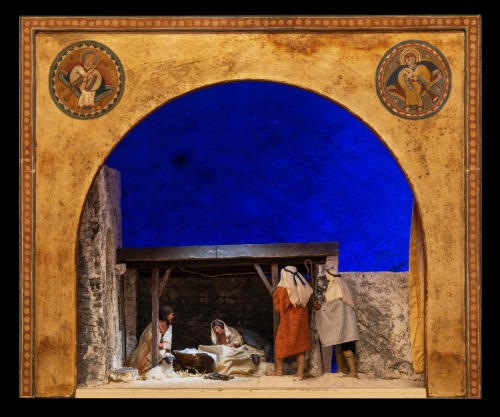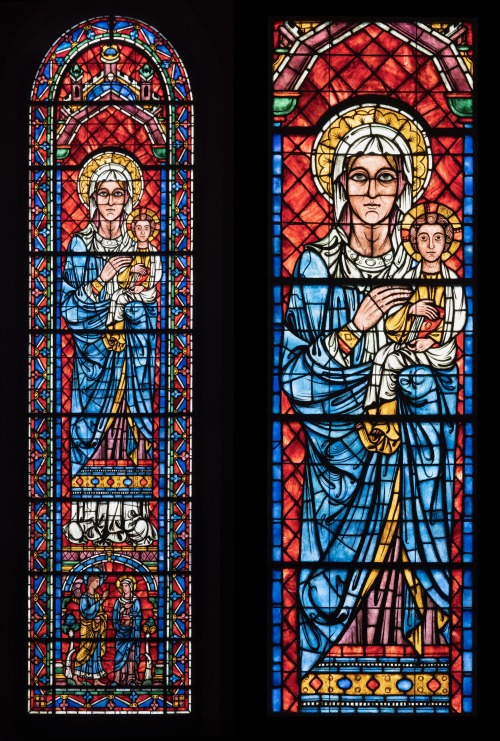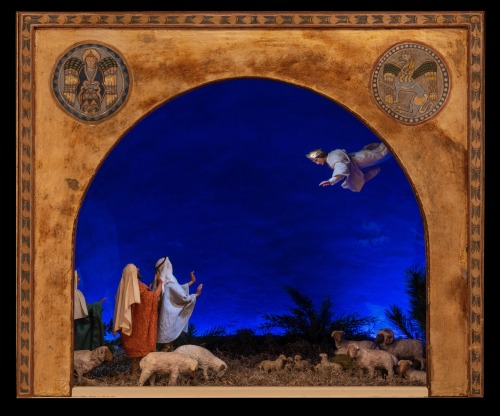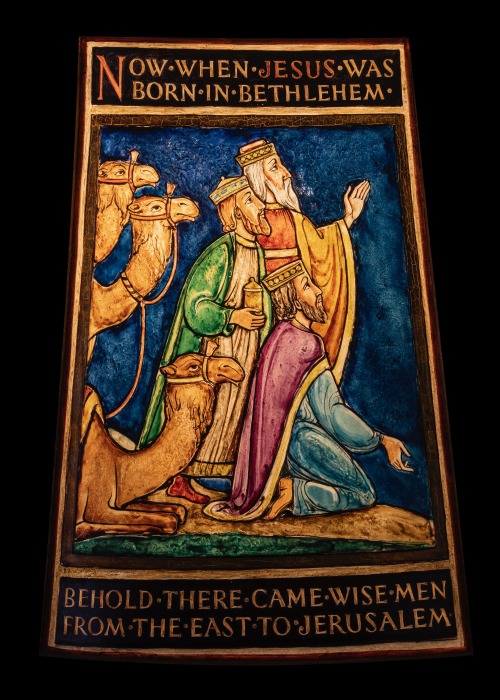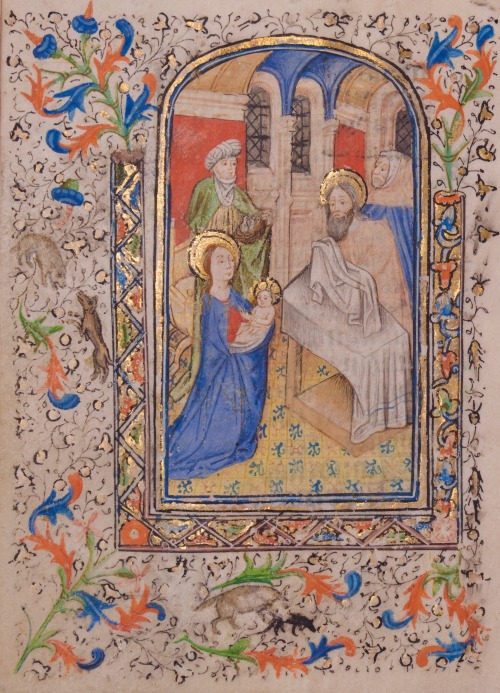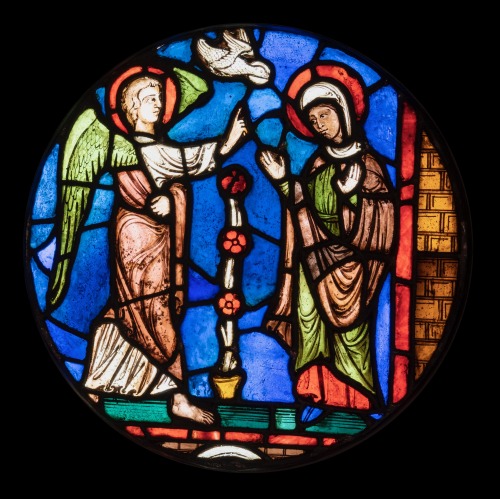#nativities
ADVENT CALENDAR DAY 5
Page from a 15th-century Book of Hours, likely made in Northeast France. Glencairn Museum, Bryn Athyn, PA, 07.MS.639.
This scene of the Wise Men presenting their gifts to the Christ Child is from a page in a 15th-century Flemish medieval prayer book known as the Book of Hours. These personal prayer books contained devotions appropriate for the eight canonical hours of the day, as well as other prayers and texts. According to the Gospel of Matthew, “And when they had come into the house, they saw the young Child with Mary His mother, and fell down and worshiped Him. And when they had opened their treasures, they presented gifts to Him: gold, frankincense, and myrrh” (2:11).
Here the gifts of the Wise Men take the form of three golden chalices. Both the Christ Child, who sits on Mary’s lap, and Mary herself, have haloes, but the infant Christ’s halo incorporates the sign of the cross. The clothing of the Wise Men suggests that they have come from three different of countries, while their hair and beards suggest three different ages: youth, adult, and old age. In the left-hand border of the page, two hounds are depicted chasing a white rabbit. Below the main scene is a peacock.
Every day, from December 1 through December 25, a new work of Nativity art from the Glencairn Museum collection will appear on the home page of our Advent calendar (Follow the Star: A 2021 Advent Calendar). To receive these in your newsfeed, follow our social media (Facebook, Instagram, Twitter, Tumblr).
Post link
ADVENT CALENDAR DAY 4
Stained-glass panel by Winfred S. Hyatt and Lawrence Saint from the Christmas window in Glencairn’s Chapel. The window was made from 1928 to 1956. Glencairn Museum, Bryn Athyn, PA.
This stained-glass panel, made in the Bryn Athyn glassworks, depicts the visit of the Wise Men (sometimes called Magi) to the infant Jesus, with the Star of Bethlehem shining above. According to the Gospel of Matthew, “When they saw the star, they rejoiced exceedingly with great joy; and going into the house they saw the child with Mary his mother, and they fell down and worshiped him. Then, opening their treasures, they offered him gifts, gold and frankincense and myrrh” (2:9–12). This scene is in the Christmas window on the south wall of Glencairn’s Chapel.
The meaning of the term Magi (in Greek magoi) in the context of Matthew’s narrative has been a topic of discussion since the early days of the Christian Church. They have been variously described as “sages,” “diviners,” “astrologers,” or “priests.” As early as the third century, however, some interpreters of the Bible began to identify the Wise Men as kings, in connection with a prophesy found in the Book of Psalms in the Hebrew Bible: “May the kings of Tarshish and of the isles render him tribute, may the kings of Sheba and Seba bring gifts!” (Psalm 72:10). By the time of the Middle Ages, the “three kings” were being depicted in art with crowns and elaborate garments.
Every day, from December 1 through December 25, a new work of Nativity art from the Glencairn Museum collection will appear on the home page of our Advent calendar (Follow the Star: A 2021 Advent Calendar). To receive these in your newsfeed, follow our social media (Facebook, Instagram, Twitter, Tumblr).
Post link
ADVENT CALENDAR DAY 3
Stone with polychromy, made in France during the late 15th-century. Glencairn Museum, Bryn Athyn, PA, 09.SP.83.
According to the Gospel of Luke (1:39–56), after the angel Gabriel told Mary that she would give birth to Jesus, the Son of God, she traveled to visit her cousin Elizabeth. This event is commonly called the Visitation. In this 15th-century sculpture group from France, Mary (left), who is pregnant with Jesus, holds a rosary, a set of prayer beads often seen in medieval art. Elizabeth, who is pregnant with John the Baptist, touches her cousin’s womb. According to Luke, when Elizabeth heard the greeting of Mary she was filled with the Holy Spirit, and proclaimed, “Blessed are you among women, and blessed is the fruit of your womb!” (1:42). This sculptural group may have been made for a private chapel dedicated to either Saint Elizabeth or Saint John the Baptist.
Every day, from December 1 through December 25, a new work of Nativity art from the Glencairn Museum collection will appear on our website (Follow the Star: A 2021 Advent Calendar. To receive these in your newsfeed, follow the Museum’s social media (Facebook, Instagram, Twitter, Tumblr).
Post link
ADVENT CALENDAR DAY TWO
Stained-glass panel by Winfred S. Hyatt from the Christmas window in Glencairn’s Chapel in Bryn Athyn, PA. The window was made by Lawrence Saint and Winfred Hyatt from 1928 to 1956. Glencairn Museum, Bryn Athyn, PA.
This stained-glass panel, made in the Bryn Athyn glassworks, depicts the moment when the angel Gabriel announces to Mary, who is resting on a bed indoors, that she has been chosen to be the mother of Jesus Christ. According to the Gospel of Luke, the angel said, “Behold, you will conceive in your womb and bring forth a Son, and shall call His name Jesus” (1:31). The scene is at the top of the Christmas window on the south wall of Glencairn’s Chapel. While the lower scenes in this window were copied from the original 13th-century church of Sainte-Radegonde outside the city of Poitiers, France, this Annunciation seems to have been designed by Bryn Athyn artist Winfred S. Hyatt. (An Annunciation scene has not survived from the window at Sainte-Radegonde.)
Every day, from December 1 through December 25, a new work of Nativity art from the Glencairn Museum collection will appear on our website (Follow the Star: A 2021 Advent Calendar). To receive these in your newsfeed, follow the Museum’s social media (Facebook, Instagram, Twitter, Tumblr).
Post link
ADVENT CALENDAR DAY ONE
Fresco by an unknown artist from the Clarissan monastery of Santa Maria inter Angelos, near Spoleto, Italy (c. 1300). Glencairn Museum, Bryn Athyn, PA, 08.FS.07.
The story of the Annunciation to Mary comes from the Gospel of Luke (1:26–38), in which the angel Gabriel appears to Mary and informs her that she will give birth to Jesus, the Son of God. This large, 13th-century Italian fresco in Glencairn’s Great Hall depicts the moment when Gabriel delivers this astonishing news. The angel says to her, “Do not be afraid, Mary, for you have found favor with God. And behold, you will conceive in your womb and bring forth a Son, and shall call His name Jesus.” (Luke 1:30–31). Gabriel, on the right with wings and a halo, walks toward Mary with his hands in a gesture of blessing. Mary, also wearing a halo, inclines her head, which is covered with a cloak, to Gabriel.
Every day, from December 1 through December 25, a new work of Nativity art from the Glencairn Museum collection will appear on our website (Follow the Star: A 2021 Advent Calendar). To receive these in your newsfeed, follow the Museum’s social media (Facebook, Instagram, Twitter, Tumblr).
Post link
According to tradition, a Moravian Star should be displayed beginning on the first Sunday in Advent (the fourth Sunday before Christmas) until Epiphany (January 6). The Herrnhut Star Company in Herrnhut, East Saxony, Germany, has been producing Moravian Stars for over 160 years. The star on exhibit in Glencairn’s Upper Hall was originally given as a gift to Oskar Boehm by his sister Erna Pfueller (née Boehm). Oskar, his wife Anna, and their children had immigrated from Germany’s Erzgebirge region to the United States in 1928. Edna remained in Germany, and following World War II the region where she lived became part of the German Democratic Republic (East Germany). In the 1950s Erna mailed the star from Germany to Oskar’s family as a gift. Oskar worked as a sexton for St. James Methodist Church on Tabor Road in Philadelphia, and for many years it was displayed in that church at Christmastime. (Gift of Helmut and Elfriede Boehm)
Check out this year’s “Christmas at Glencairn” events here: https://bit.ly/ChristmasAtGlencairn
Post link
The 100+ figures in this large 19th- and 20th-century Presepio were collected in Italy over a period of more than thirty years by the late Elizabeth Anne Evans of Bucks County. A Presepio, which has been called “the translation of the Bible into Neapolitan dialect,” represents daily life in 18th-century Naples, a bustling port city. The miracle of the Nativity is depicted as taking place amid crumbling Roman ruins, signifying the end of the old Roman world and the dawn of Christianity. (Suggested donation to Glencairn’s World Nativities” exhibition is $5.) https://bit.ly/ChristmasAtGlencairn
Post link
ADVENT CALENDAR DAY 25
Raymond and Mildred Pitcairn pose for their 1954 Christmas card picture beside the Days of Creation fireplace in Glencairn’s Upper Hall. The Bryn Athyn Historic District Archives, Bryn Athyn, PA.
A life-size oil painting of the Adoration of the Shepherds (Luke 2:15–20) hung above the fireplace in Glencairn’s Upper Hall for many years. The painting was based on an illustration in The Christ Child, a children’s book by Maud and Miska Petersham. The Petershams, a husband-and-wife team, were well known in the first half of the 20th century as illustrators and authors of children’s literature. Raymond and Mildred Pitcairn loved the Petershams’ illustrations, and in the late 1930s they commissioned artist Frank Snyder to paint the large interpretation of the illustration from The Christ Child for their Bryn Athyn home.
When Glencairn became a museum in the early 1980s, Snyder’s original painting from the 1930s was found to be damaged beyond repair. In 2016 a reinterpretation of the Petersham illustration was painted by Bryn Athyn artist Edwin Herder, which now hangs above Glencairn’s fireplace each Christmas season.
Every day, from December 1 through December 25, a new work of Nativity art from the Glencairn Museum collection has appeared on the home page of our Advent calendar (Follow the Star: A 2021 Advent Calendar).
Post link
ADVENT CALENDAR DAY 24
Panel depicting two angels in a scene from the Nativity; possibly from the Infancy of Christ window in the Cathedral of Notre-Dame in Clermont-Ferrand, France. Glencairn Museum, Bryn Athyn, PA, 03.SG.10.
In this stained-glass window fragment from 12th-century France, two winged angels, dressed in white robes with murrey-colored mantles, are positioned on either side of a yellow Star of Bethlehem. The star is a clear reference to the journey of the Wise Men, described in the Gospel of Matthew: “When they heard the king, they departed; and behold, the star which they had seen in the East went before them, till it came and stood over where the young Child was” (2:9).
The two angels gesture downward to a curving line at the bottom of the fragment. This was originally the top of the opening of the cave in which the birth of the Christ Child took place. The choice of a cave, instead of a stable, as the location of the Nativity miracle, suggests that this window was influenced by Byzantine examples. (The earliest Christians located the birth of Jesus in a cave, and this was the standard depiction in Byzantine art of the 12th century.)
Every day, from December 1 through December 25, a new work of Nativity art from the Glencairn Museum collection will appear on the home page of our Advent calendar (Follow the Star: A 2021 Advent Calendar). To receive these in your newsfeed, follow our social media (Facebook, Instagram, Twitter, Tumblr).
Post link
ADVENT CALENDAR DAY 23
This 15th-century limestone sculpture of Mary holding the Christ Child was made in France. Glencairn Museum, Bryn Athyn, PA, 09.SP.114.
This 15th-century limestone sculpture in Glencairn’s Great Hall features Mary, who is slightly less than life-size, standing and holding the Christ Child. She wears a crown and veil, and a mantle over her gown, which is girdled at the waist. This statue explores the earthly aspects of the relationship between the Christ Child and His mother. Mary looks tenderly toward the infant Child, who returns her gaze. In classic Gothic style, these figures engage each other through their eyes and gestures. With His right hand, Jesus touches her breast, and clasps her neck with His left hand. Sculptures of Mary standing with the Child in her arms was a major development in imagery that occurred in the 13th century. It evolved from both theological and artistic innovations, and is a major contrast with the earlier, more rigid Romanesque style.
Every day, from December 1 through December 25, a new work of Nativity art from the Glencairn Museum collection will appear on the home page of our Advent calendar (Follow the Star: A 2021 Advent Calendar). To receive these in your newsfeed, follow our social media (Facebook, Instagram, Twitter, Tumblr).
Post link
ADVENT CALENDAR DAY 22
The Flight into Egypt, from the 12th-century Infancy of Christ window of the Abbey Church of Saint-Denis, France. Glencairn Museum, Bryn Athyn, PA, 03.SG.114.
Three consecutive verses in the Gospel of Matthew (2:13–15) are the only biblical source for the story of the Flight into Egypt. According to Matthew, after the visit of the Wise Men, “an angel of the Lord appeared to Joseph in a dream, saying, ‘Arise, take the young Child and His mother, flee to Egypt, and stay there until I bring you word; for Herod will seek the young Child to destroy Him’” (2:13). Although the Bible provides very little information about this episode in the Nativity narrative, it is frequently depicted in art. Usually Mary is shown riding a donkey with Jesus on her lap, accompanied by Joseph and sometimes a servant.
Glencairn’s medieval stained-glass example of the Flight into Egypt formed part of the Infancy of Christ window at the Abbey Church at Saint-Denis. It illustrates an incident in the story not included in the canonical Christian gospels in the Bible. According to the early Christian apocryphal Infancy Gospel of Pseudo-Matthew, on the third day of the journey Mary became fatigued by the desert heat, and the Holy Family took refuge under the shade of a date palm. When Mary expressed a wish for some of the tree’s fruit, the Christ Child commanded the palm, saying, “O tree, bend your branches, and refresh my mother with your fruit.” Immediately the tree obeyed and they gathered its fruit (chapters 20–21).
Every day, from December 1 through December 25, a new work of Nativity art from the Glencairn Museum collection will appear on the home page of our Advent calendar (Follow the Star: A 2021 Advent Calendar). To receive these in your newsfeed, follow our social media (Facebook, Instagram, Twitter, Tumblr).
Post link
ADVENT CALENDAR DAY 21
Diorama of the Annunciation to the Shepherds by Winfred S. Hyatt, made around 1925. Glencairn Museum, Bryn Athyn, PA, C37.
This scene shows the Annunciation to the Shepherds (Luke 2:8–14), from the narrative of the Nativity of Jesus Christ. Here an angel in a white robe, and wearing a golden crown, descends from above, telling the shepherds that they will “find a babe wrapped in swaddling cloths and lying in a manger.“
Winfred S. Hyatt made three Nativity scenes for the Raymond and Mildred Pitcairn family during the 1920s; this scene is one of the three. Hyatt, the principal stained-glass artist and designer for Bryn Athyn Cathedral and later Glencairn, also made Nativity scenes for the Cathedral, the Harold Pitcairn family, and President and Mrs. Eisenhower. Hyatt modeled all the figures for the Pitcairn scenes, which were then cast in plaster, painted, and clothed.
Every day, from December 1 through December 25, a new work of Nativity art from the Glencairn Museum collection will appear on the home page of our Advent calendar (Follow the Star: A 2021 Advent Calendar). To receive these in your newsfeed, follow our social media (Facebook, Instagram, Twitter, Tumblr).
Post link
ADVENT CALENDAR DAY 20
This large stained-glass window featuring Mary holding the Christ Child is in the west wall of Glencairn’s Great Hall. Glencairn Museum, Bryn Athyn, PA.
This large stained-glass window featuring Mary holding the Christ Child is one of nine lancet windows in Glencairn’s Great Hall. Six of the windows, including this one, are based on medieval originals in Chartres Cathedral (in the town of Chartres, some 60 miles southwest of Paris). These windows were reproduced in the 1930s by the Bryn Athyn stained-glass studio and glassworks.
Although based on a medieval original, Raymond Pitcairn reinterpreted the subject of this window. The original version, located in the central lancet beneath the north rose window at Chartres, depicts Saint Anne holding her daughter, the infant Mary. The Glencairn version was altered to depict Mary holding the infant Jesus.
Every day, from December 1 through December 25, a new work of Nativity art from the Glencairn Museum collection will appear on the home page of our Advent calendar (Follow the Star: A 2021 Advent Calendar). To receive these in your newsfeed, follow our social media (Facebook, Instagram, Twitter, Tumblr).
Post link
ADVENT CALENDAR DAY 19
Limestone relief with the Adoration of the Wise Men, 13th-century France. (Detail photo on top.) Glencairn Museum, Bryn Athyn, PA, 09.SP.85.
This limestone relief featuring the Adoration of the Wise Men was made in 14th-century France. It illustrates how these travelers came from the east in search of the Christ Child. According to the Gospel of Matthew, “when they had come into the house, they saw the young Child with Mary His mother, and fell down and worshiped Him. And when they had opened their treasures, they presented gifts to Him: gold, frankincense, and myrrh” (2:11). In the center of the relief, Mary and the Child are seated on a throne. The three Wise Men, all crowned, are approaching from the left, with the foremost kneeling down to present his gift.
A winged angel stands at the left, behind the third Wise Man. At the far left is a crowned king, seated and holding a harp; this is likely King David, who in the Middle Ages was believed to be the author of the Book of Psalms (sacred songs). To the right of the central scene is another winged angel, this time accompanied by a woman; this no doubt represents the Annunciation to Mary. The meaning of the other scenes is unclear. During the construction of Glencairn, Raymond Pitcairn set this relief into the west wall of the Great Hall, where it remains today.
Every day, from December 1 through December 25, a new work of Nativity art from the Glencairn Museum collection will appear on the home page of our Advent calendar (Follow the Star: A 2021 Advent Calendar). To receive these in your newsfeed, follow our social media (Facebook, Instagram, Twitter, Tumblr).
Post link
ADVENT CALENDAR DAY 18
Diorama of the Annunciation to the Shepherds by Winfred S. Hyatt, made around 1925. Glencairn Museum, Bryn Athyn, PA, C37.
This scene shows the Annunciation to the Shepherds (Luke 2:8–14), from the narrative of the Nativity of Jesus Christ. Here an angel in a white robe, and wearing a golden crown, descends from above, telling the shepherds that they will “find a babe wrapped in swaddling cloths and lying in a manger.“
Winfred S. Hyatt made three Nativity scenes for the Raymond and Mildred Pitcairn family during the 1920s; this scene is one of the three. Hyatt, the principal stained-glass artist and designer for Bryn Athyn Cathedral and later Glencairn, also made Nativity scenes for the Cathedral, the Harold Pitcairn family, and President and Mrs. Eisenhower. Hyatt modeled all the figures for the Pitcairn scenes, which were then cast in plaster, painted, and clothed.
Every day, from December 1 through December 25, a new work of Nativity art from the Glencairn Museum collection will appear on the home page of our Advent calendar (Follow the Star: A 2021 Advent Calendar). To receive these in your newsfeed, follow our social media (Facebook, Instagram, Twitter, Tumblr).
Post link
ADVENT CALENDAR DAY 17
This stained-glass panel with the Presentation in the Temple was made by Lawrence Saint around 1919. Glencairn Museum, Bryn Athyn, PA, 03.SG.353.
This panel from a Christmas window features the Presentation in the Temple. According to the Gospel of Luke, after Jesus was born Joseph and Mary traveled to Jerusalem to present the Christ Child at the Temple. The architectural context of the story is here emphasized in stained glass by the inclusion of a wall with turrets located just above the main scene. While the family was there, the Holy Spirit visited a man named Simeon and revealed to him that Jesus was the Messiah. The scene illustrates the part of the story where Simeon takes Jesus into his arms and proclaims Him to be “a light to bring revelation to the Gentiles, and the glory of Your people Israel” (2:32).
This panel, together with three others from a Christmas window, was originally located in Bryn Athyn Cathedral. It was later placed in storage, where it remained until it was rediscovered in the late 1980s.
Every day, from December 1 through December 25, a new work of Nativity art from the Glencairn Museum collection will appear on the home page of our Advent calendar (Follow the Star: A 2021 Advent Calendar). To receive these in your newsfeed, follow our social media (Facebook, Instagram, Twitter, Tumblr).
Post link
ADVENT CALENDAR DAY 16
This panel from a plexiglas lampshade, painted by Frank Snyder in the 1930s or 1940s, features an illustration of the Journey of the Wise Men. Glencairn Museum, Bryn Athyn, PA, 11.OP.02.
Glencairn’s family Chapel has a floor lamp with a handcrafted, six-paneled lampshade depicting scenes from the story of the birth of Jesus Christ. Each one of the illustrations is accompanied by a biblical quotation. In the panel pictured here, the Wise Men are depicted at night with their camels, following the Star of Bethlehem: “Now after Jesus was born in Bethlehem of Judea in the days of Herod the king, behold, wise men from the East came to Jerusalem, saying, ‘Where is He who has been born King of the Jews? For we have seen His star in the East and have come to worship Him’” (Matthew 2:1–2).
Raymond Pitcairn commissioned artist Francis (“Frank”) Eugene Snyder to design and create this lampshade in the 1930s or 1940s when Glencairn was being decorated. It is made from plexiglas panels, which Synder painted with oils. By using a variety of media, he was able to achieve the appearance and texture of stained glass when the light is turned on.
Every day, from December 1 through December 25, a new work of Nativity art from the Glencairn Museum collection will appear on the home page of our Advent calendar (Follow the Star: A 2021 Advent Calendar). To receive these in your newsfeed, follow our social media (Facebook, Instagram, Twitter, Tumblr).
Post link
ADVENT CALENDAR DAY 15
Page from a 15th-century Book of Hours, likely made in Northeast France. Glencairn Museum, Bryn Athyn, PA, 07.MS.639.
This scene of the Presentation in the Temple is from a page in a 15-century Flemish prayer book. Known as a Book of Hours, these personal prayer books contained devotions appropriate for the eight canonical hours of the day, as well as other prayers and texts. According to the Gospel of Luke, after Jesus was born Joseph and Mary traveled to the Temple in Jerusalem. While they were there, the Holy Spirit visited Simeon and revealed to him that Jesus was the Messiah. Simeon then proclaimed the child to be “a light to bring revelation to the Gentiles, and the glory of Your people Israel” (2:32).
Mary is here depicted carrying Jesus toward Simeon, who prepares to receive the child with a white cloth. Mary, Jesus, and Simeon all have haloes. The woman on the left, perhaps the prophetess Anna (2:36), holds three birds—no doubt a reference to the “pair of turtledoves or two young pigeons” intended for sacrifice in accordance with the law (2:24). In the borders of the page, brown dogs hunt a pig (left) and a small black mammal (perhaps a stoat).
Every day, from December 1 through December 25, a new work of Nativity art from the Glencairn Museum collection will appear on the home page of our Advent calendar (Follow the Star: A 2021 Advent Calendar). To receive these in your newsfeed, follow our social media (Facebook, Instagram, Twitter, Tumblr).
Post link
ADVENT CALENDAR DAY 14
Stained-glass panel depicting the Annunciation to Mary made in 13th century France. Glencairn Museum, Bryn Athyn, PA, 03.SG.236.
This stained-glass panel, made in 13th-century France, recounts the moment when Mary was told by the angel Gabriel that she has been chosen to be the mother of Jesus Christ. According to the Gospel of Luke, the angel said, “Behold, you will conceive in your womb and bring forth a Son, and shall call His name Jesus” (1:31).
On the left, the winged angel Gabriel walks toward Mary with his hand raised in greeting. Mary stands before Gabriel with the palms of her hands facing outward. This gesture signals Mary’s acceptance of what she is being told and her willingness to receive the Holy Spirit (represented by the dove flying toward her). The two figures are separated by a vase with a tall spray of roses, a flower closely associated with Mary.
Every day, from December 1 through December 25, a new work of Nativity art from the Glencairn Museum collection will appear on the home page of our Advent calendar (Follow the Star: A 2021 Advent Calendar). To receive these in your newsfeed, follow our social media (Facebook, Instagram, Twitter, Tumblr).
Post link
ADVENT CALENDAR DAY 13
Scene of the journey of the Wise Men, made by Winfred S. Hyatt around 1925. Glencairn Museum, Bryn Athyn, PA, C37.
This scene shows the Wise Men gazing at the Star of Bethlehem; having seen the star in the East, they are now following it in order to find and worship the Christ Child (Gospel of Matthew 2:2).
Winfred S. Hyatt made three Nativity scenes for the Raymond Pitcairn family during the 1920s; this scene is one of the three. Hyatt, the principal stained-glass artist and designer for Bryn Athyn Cathedral and later Glencairn, also made Nativity scenes for the Cathedral, the Harold Pitcairn family, and President and Mrs. Eisenhower. Hyatt modeled all the figures for the Pitcairn scenes, which were then cast in plaster, painted, and clothed.
Every day, from December 1 through December 25, a new work of Nativity art from the Glencairn Museum collection will appear on the home page of our Advent calendar (Follow the Star: A 2021 Advent Calendar). To receive these in your newsfeed, follow our social media (Facebook, Instagram, Twitter, Tumblr).
Post link
ADVENT CALENDAR DAY 12
Stained-glass panel with the Adoration of the Wise Men, made by Lawrence Saint around 1919. Glencairn Museum, Bryn Athyn, PA, 03.SG.356.
This panel from a Christmas window features the Adoration of the Wise Men. It is part of a two-light, four-panel window designed by stained-glass artist Lawrence Saint around the year 1919. Here Mary holds Jesus on her lap while the Wise Men present the Christ Child with gifts of “gold, frankincense, and myrrh” (Gospel of Matthew 2:9–12).
Lawrence Saint, who had his own stained-glass studio just down the road from Bryn Athyn Cathedral in Huntingdon Valley, worked as a glass artist for the Cathedral early in his career. He later became nationally recognized for his stained-glass work on the National Cathedral in Washington, D.C. This Christmas window was originally located in Bryn Athyn Cathedral, but was later placed in storage, where it remained until it was rediscovered in the late 1980s.
Every day, from December 1 through December 25, a new work of Nativity art from the Glencairn Museum collection will appear on the home page of our Advent calendar (Follow the Star: A 2021 Advent Calendar). To receive these in your newsfeed, follow our social media (Facebook, Instagram, Twitter, Tumblr).
Post link
ADVENT CALENDAR DAY 9
Watercolor painting by Maud Petersham, from Woodstock, New York (1961). Glencairn Museum, Bryn Athyn, PA, 07.WC.1225.
This watercolor painting of the Presentation in the Temple, an early episode in the life of Jesus Christ, was made by Maud Petersham, an artist from Woodstock, New York. According to the biblical account, after Jesus was born Joseph and Mary traveled to Jerusalem to present their newborn child at the temple, as required by law. While they were at the temple, the Holy Spirit visited a man named Simeon and revealed to him that Jesus was the Messiah. Simeon then took Jesus into his arms, said a prayer, and blessed them (Gospel of Luke 2:25–35).
Maud and Miska Petersham, a husband-and-wife artist team, were well known in the first half of the 20th century as illustrators and authors of children’s literature. Their illustrations were a special favorite with Mildred Pitcairn. This painting was commissioned by Raymond and Mildred Pitcairn in 1961, and was sent from Glencairn as their Christmas card that year.
Every day, from December 1 through December 25, a new work of Nativity art from the Glencairn Museum collection will appear on the home page of our Advent calendar (Follow the Star: A 2021 Advent Calendar. To receive these in your newsfeed, follow our social media (Facebook, Instagram, Twitter, Tumblr).
Post link
ADVENT CALENDAR DAY 8
Limestone relief of the Adoration of the Wise Men, 13th-century France. (Detail photo on top.) Glencairn Museum, Bryn Athyn, PA, 09.SP.119.
This limestone relief with the Adoration of the Wise Men was made in 13th-century France. It illustrates the biblical story describing these travelers, who came “from the East,” saying, “Where is He who has been born King of the Jews? For we have seen His star in the East and have come to worship Him” (Gospel of Matthew 2:1–2).
During the construction of Glencairn, Raymond Pitcairn set this relief into the north wall of the inglenook in the Great Hall, where it remains today. All three of the Wise Men are represented as kings wearing crowns, in keeping with medieval tradition. The foremost king, whose arm is broken off, is shown kneeling to present a gift—either gold, frankincense, or myrrh (Matthew 2:11).
Every day, from December 1 through December 25, a new work of Nativity art from the Glencairn Museum collection will appear on the home page of our Advent calendar (Follow the Star: A 2021 Advent Calendar). To receive these in your newsfeed, follow our social media (Facebook, Instagram, Twitter, Tumblr).
Post link
ADVENT CALENDAR DAY 7
Lampshade panel illustrating the Visitation of the Shepherds, made in the late 1930s or early 1940s. Glencairn Museum, Bryn Athyn, PA, 11.OP.02.
This handcrafted lampshade panel illustrates the Visitation of the Shepherds. According to the Gospel of Luke, “So it was, when the angels had gone away from them into heaven, that the shepherds said to one another, ‘Let us now go to Bethlehem and see this thing that has come to pass, which the Lord has made known to us’” (2:15).
The panel is one of six scenes from the Nativity narrative decorating a Christmas-themed lampshade in Glencairn’s Chapel. The plexiglass shade was commissioned by Raymond Pitcairn in the late 1930s or early 1940s; it was designed and painted by Francis (“Frank”) Eugene Snyder (1908–1995). Synder painted the plexiglass with oils and other media in order to achieve the appearance and texture of stained glass when the lamp is turned on.
Every day, from December 1 through December 25, a new work of Nativity art from the Glencairn Museum collection will appear on the home page of our Advent calendar (Follow the Star: A 2021 Advent Calendar. To receive these in your newsfeed, follow our social media (Facebook, Instagram, Twitter, Tumblr).
Post link
ADVENT CALENDAR DAY 6
Stained-glass roundel of the Annunciation to the Shepherds made in 13th-century France. Glencairn Museum, Bryn Athyn, PA, 03.SG.240.
This 13th-century stained-glass roundel illustrates the biblical story of the Annunciation to the Shepherds (Luke 2:8–14). Here an angel with green wings and a purple cloak descends from a heavenly cloud, announcing to the shepherds that they will “find a babe wrapped in swaddling cloths and lying in a manger.”
According to Professor Michael W. Cothren, “Medieval artists commonly used a wavy, arching band of clouds (frequently placed across the corner of a rectangular composition) to show a separation between the earthly realm below and the heavenly realm above. For example, when a disembodied hand of God emerges from heaven to command or bless a situation taking place on earth, it is often overlapped by an arching band of ‘clouds of heaven.’ Sometimes the face of God appears within the cloud band. Sometimes angels swoop down toward earth underneath or emerging from the clouds.” (“The ‘Clouds of Heaven’ Motif in Art Created for Glencairn,” Glencairn Museum News No. 1, 2021).
Every day, from December 1 through December 25, a new work of Nativity art from the Glencairn Museum collection will appear on the home page of our Advent calendar (Follow the Star: A 2021 Advent Calendar). To receive these in your newsfeed, follow our social media (Facebook, Instagram, Twitter, Tumblr).
Post link




